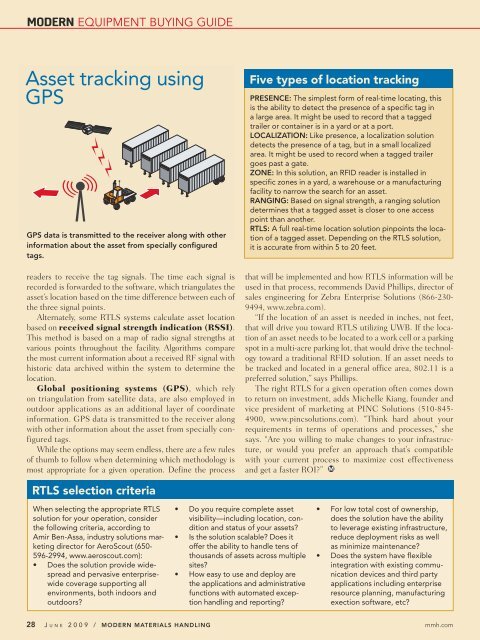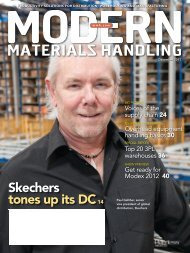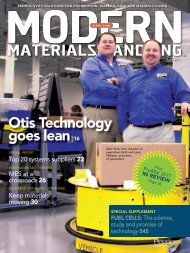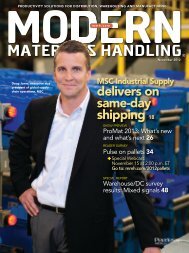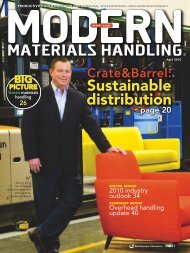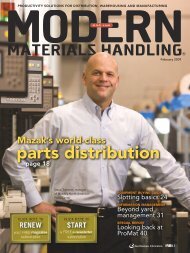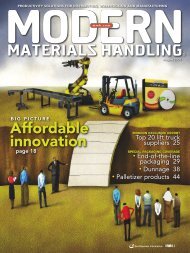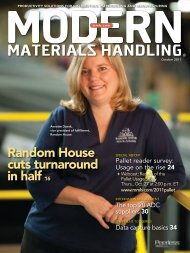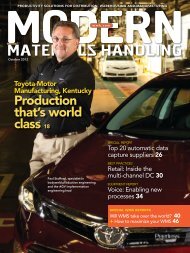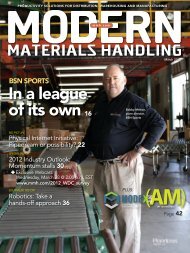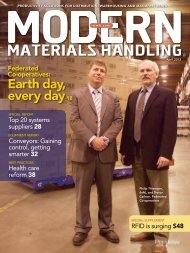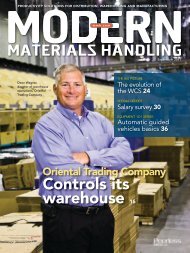June - Modern Materials Handling
June - Modern Materials Handling
June - Modern Materials Handling
- No tags were found...
Create successful ePaper yourself
Turn your PDF publications into a flip-book with our unique Google optimized e-Paper software.
modern EQUIPMENT BUYING GUIDEAsset tracking usingGPSGPS data is transmitted to the receiver along with otherinformation about the asset from specially configuredtags.readers to receive the tag signals. The time each signal isrecorded is forwarded to the software, which triangulates theasset’s location based on the time difference between each ofthe three signal points.Alternately, some RTLS systems calculate asset locationbased on received signal strength indication (RSSI).This method is based on a map of radio signal strengths atvarious points throughout the facility. Algorithms comparethe most current information about a received RF signal withhistoric data archived within the system to determine thelocation.Global positioning systems (GPS), which relyon triangulation from satellite data, are also employed inoutdoor applications as an additional layer of coordinateinformation. GPS data is transmitted to the receiver alongwith other information about the asset from specially configuredtags.While the options may seem endless, there are a few rulesof thumb to follow when determining which methodology ismost appropriate for a given operation. Define the processFive types of location trackingPRESENCE: The simplest form of real-time locating, thisis the ability to detect the presence of a specific tag ina large area. It might be used to record that a taggedtrailer or container is in a yard or at a port.LOCALIZATION: Like presence, a localization solutiondetects the presence of a tag, but in a small localizedarea. It might be used to record when a tagged trailergoes past a gate.ZONE: In this solution, an RFID reader is installed inspecific zones in a yard, a warehouse or a manufacturingfacility to narrow the search for an asset.RANGING: Based on signal strength, a ranging solutiondetermines that a tagged asset is closer to one accesspoint than another.RTLS: A full real-time location solution pinpoints the locationof a tagged asset. Depending on the RTLS solution,it is accurate from within 5 to 20 feet.that will be implemented and how RTLS information will beused in that process, recommends David Phillips, director ofsales engineering for Zebra Enterprise Solutions (866-230-9494, www.zebra.com).“If the location of an asset is needed in inches, not feet,that will drive you toward RTLS utilizing UWB. If the locationof an asset needs to be located to a work cell or a parkingspot in a multi-acre parking lot, that would drive the technologytoward a traditional RFID solution. If an asset needs tobe tracked and located in a general office area, 802.11 is apreferred solution,” says Phillips.The right RTLS for a given operation often comes downto return on investment, adds Michelle Kiang, founder andvice president of marketing at PINC Solutions (510-845-4900, www.pincsolutions.com). “Think hard about yourrequirements in terms of operations and processes,” shesays. “Are you willing to make changes to your infrastructure,or would you prefer an approach that’s compatiblewith your current process to maximize cost effectivenessand get a faster ROI?”RTLS selection criteriaWhen selecting the appropriate RTLSsolution for your operation, considerthe following criteria, according toAmir Ben-Assa, industry solutions marketingdirector for AeroScout (650-596-2994, www.aeroscout.com):• Does the solution provide widespreadand pervasive enterprisewidecoverage supporting allenvironments, both indoors andoutdoors?• Do you require complete assetvisibility—including location, conditionand status of your assets?• Is the solution scalable? Does itoffer the ability to handle tens ofthousands of assets across multiplesites?• How easy to use and deploy arethe applications and administrativefunctions with automated exceptionhandling and reporting?• For low total cost of ownership,does the solution have the abilityto leverage existing infrastructure,reduce deployment risks as wellas minimize maintenance?• Does the system have flexibleintegration with existing communicationdevices and third partyapplications including enterpriseresource planning, manufacturingexection software, etc?28 J UNE 2009 / MODERN MATERIALS HANDLING mmh.com


